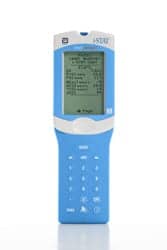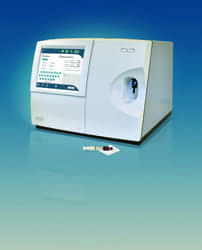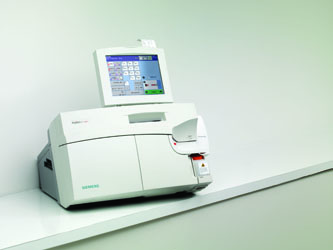 The i-STAT System from Abbott Point of Care is a single-use, cartridge-based system that has an extensive menu.These instruments have footprints that allow them to be placed in near-patient testing sites or at the patient’s bedside
The i-STAT System from Abbott Point of Care is a single-use, cartridge-based system that has an extensive menu.These instruments have footprints that allow them to be placed in near-patient testing sites or at the patient’s bedside
BY CRAIG FOREBACK, PHD
An earlier article titled “Blood Gases: Why? Where? And What Else?” discusses the importance of doing blood gases, and provides an overview of blood gas analyzers, including additional analytes that are now available on blood gas platforms.
The article mentioned a few specific analyzers, but did not include a discussion of the many options that are available to laboratorians and point-of-care providers for providing blood gas testing and other critical care tests.
There are no less than 10 manufacturers of devices offering 24 different platforms that can quickly analyze and calculate a wide variety of important parameters. All of the available instruments have footprints that allow them to be placed in near-patient testing sites such as satellite laboratories or, in some cases, at the patient’s bedside.
Handheld Devices
There are two devices that can be easily deployed at the bedside and are small enough to be held and operated in the hand of a caregiver. The i-STAT System from Abbott Point of Care, Princeton, NJ, is a single-use, cartridge-based system that has an extensive menu (19 determinations and six calculated results), including pH, pCO2, pO2, Hct, Na, K, Cl, TCO2, iCa, lactate, glucose, creatinine, BUN, cardiac markers (BNP, CK-MB, and Troponin I), and coagulation testing (ACT Celite, ACT Kaolin, and PT/INR). It has the most comprehensive test menu on any of the 24 platforms. There are 18 different cartridges with numerous combinations of tests. For all cartridges requiring calibration (chemistries and blood gases), a one-point calibration is performed automatically as part of the cartridge testing cycle. Automated electronic QC and liquid QC are recommended for the handheld and cartridges, respectively, as directed by the facilities’ policies.
The Alere-epoc Blood Gas Analysis System, from Alere, Waltham, Mass, is a single-test, card-based system, and can measure nine parameters, including pH, pCO2, p02, Hct, Na, K, iCa, lactate, glucose, and reports six calculations. A one-point automatic calibration is required for every sample. Analysis time is 35 seconds. Both instruments weigh about 1.5 pounds, they have similar dimensions, and they can be remotely controlled by the central laboratory.
The Abbott service center can perform diagnostics through a modem, and patient and QC data can be uploaded by a hospital Ethernet or wireless network. The epoc system has no ability for remote-service diagnostics. Patient and QC data is uploaded by real-time wireless.
Both systems have a common ancestry. Imants Lauks founded i-STAT in 1983 in Ottawa, Canada. He left i-STAT in 1999, but remained in Ottawa. In 2001 he founded Epocal, and developed the epoc Blood Analysis System. Abbott Diagnostics entered into a co-marketing arrangement with i-STAT in 1998, and acquired the company in 2003. Inverness Medical Innovations Inc began an acquisition of Epocal in 2009, renamed itself Alere in 2010, and recently completed the Epocal transaction earlier this year.

There are so many choices of companies and models of benchtop analyzers that choosing one can be a daunting task. Often, the choice is influenced by the vendor that is used in the core lab. All are closed systems. Most modern blood gas analyzers no longer require gas tanks for calibrations. Many can be remotely controlled from the central laboratory and have automatic calibration. The companies and instruments will be discussed in alphabetical order.
Instrumentation Laboratory, Bedford, Mass, offers three different instruments, in the Gem Premier lineup: the Gem Premier 3000, 3500, and 4000. All three instruments can determine pH, pO2, pCO2, hematocrit, Na, K, Ca, glucose, and lactate with multiuse cartridges. In addition, the 4000 can measure total hemoglobin, oxyhemoglobin, carboxyhemoglobin, methemoglobin, reduced hemoglobin, and total bilirubin. Each instrument has a vast menu of calculated results. The 4000 has real-time wireless upload capability for patient and QC data. GEMweb Plus software allows access and control from any networked PC or GEM Premier 4000 instrument. The 3000 and 3500 upload via direct serial, Ethernet, or modem dial-in. Calibrations and QC are automatic and continuous for all three instruments. Analysis time is 85 to 95 seconds, and optimal throughput is 20 samples per hour.
ITC, Edison, NJ, markets the IRMA TRUpoint Blood Analysis System and Avoximeter co-oximiety systems. At 5.25 pounds, this device is the smallest and most portable of the benchtop analyzers. The test menu includes pH, pCO2, pO2, Hct, Na, K, Cl, iCa, glucose, BUN, creatinine, and lactate on a single-use cartridge. A two-point auto calibration is performed with each sample, and electronic QC is automatically performed every 8 hours. Patient and QC data can be uploaded through a hospital network, direct serial port, or LAN. Analysis time is 60 to 90 seconds, and optimal throughput is 20 samples per hour. The Avoximeter 4000 is a separate instrument for the performance of co-oximeter. It provides oxyhemoglobin, carboxyhemoglobin, methemoglobin, total hemoglobin, and oxygen content. Results are available within 10 seconds, and interface connectivity is available through AegisPOC™, RALS®-Plus, PrecisionWeb®/SYBASE®, and TELCOR QML®.
Medica, Bedford, Mass, offers two instruments. The Easy BloodGas performs blood gases only, while EasyStat analyzes sodium, potassium, and ionized calcium along with the three blood gas parameters. Data input is through a standard RS 232 port. Calibration is automatic or on-demand. Analysis time is 125 seconds.
Nova Biomedical, Waltham, Mass, offers a wide range of analyzers, with six different platforms available. The offerings include the Stat Profile pHOx, Stat Profile pHOx plus, Stat Profile pHOx plus C, Stat Profile pHOx L, Stat Profile pHOx Oximetry, and the Stat Profile pHOx Ultra. The pHOx test menu includes pH, pCO2, pO2, hematocrit, and hemoglobin. Each of the other analyzers adds electrolytes and other metabolites. The pHOx ultra adds 10 other analytes to the Stat Profile pHOx menu plus co-oximetry. All instruments weigh 18 pounds, with the exception of the Ultra, which weighs 61 pounds. All instruments can be controlled from the central lab. The pHOx Ultra has one of the largest test menus of any of the benchtop analyzers, and is the only one that offers ionized magnesium. QC and patient data are uploaded by serial port or a hospital network. Calibration is one- and two-point (automatic); one-point every 30 or 45 minutes or with each sample (user-selectable); two-point every 2, 4, or 6 hours (user-defined); and QC frequency is user-defined. Analysis time is about 50 seconds, but can be up to 2 minutes for the Ultra running the full test panel with co-oximetry. Maximum throughput is 50 samples per hour with the exception of the Ultra, which is 26 samples per hour.
OPTI Medical Systems, Roswell, Ga, offers the OPTI® CCA-TS Blood Gas and Electrolyte and the OPTI R analyzers, which are microprocessor-based instruments that measure all tests by optical fluorescence from discreet sensors called optical electrodes (optodes). According to the company’s website, Opti Medical’s optical fluorescent technology minimizes maintenance. The OPTI R measures pH, pCO2, pO2, total hemoglobin, SO2, sodium, potassium, and ionized calcium. In addition to the OPTI R menu, the OPTI CCA-TS includes glucose and urea nitrogen. The size and weight of the OPTI systems make them among the most portable of any of the benchtop analyzers, allowing them to be placed anywhere in a medical facility.
The OPTI quality monitor system monitors the result of each calibration verification and performs a calibration if needed, and performs automatic QC measurements to verify performance. Calibration occurs regularly every 3 hours, after every tenth sample, or based on calibration verification using the calibration solution and a low-pressure gas bottle. The OPTI R analyzer contains three different levels of liquid QC material for use in quality control and quality monitoring. Auto-QC can be programmed to run on a custom schedule. However, the OPTI R analyzer will run two levels of QC automatically to check the performance of the cassette if no QC is programmed. QC and patient data uploads are via a direct serial port or a hospital Ethernet.
Radiometer America, Westlake, Ohio, offers three instruments: the ABL800 FLEX, the ABL80 FLEX, and the ABL90 Flex. The ABL800 has an extensive test menu, including pH, pCO2, pO2, hemoglobin, Na, K, Cl, iCa, lactate, glucose, bilirubin, creatinine, fetal hemoglobin, and co-oximetry. The ABL800 requires low-pressure premixed tanks for calibration, and is the largest of the three instruments at 70 pounds. The ABL80 includes pH, pCO2, pO2, hematocrit, Na, K, iCa, Cl-, glu, hemoglobin, and co-oximetry. The ABL90 Flex measures pH, pCo2, p02, hemoglobin, Na, K, Cl, iCa, lactate, glucose, and co-oximetry. All three instruments can be controlled from the central laboratory. QC and patient data can be up loaded via real-time wireless with the Ultra. Throughput is 50 samples per hour for the ABL90 (35 seconds analysis time), 25 samples per hour for the ABL800 (60 seconds analysis time), and 30 samples per hour for the ABL80 (70 seconds analysis time).
Roche Diagnostics, with North American headquarters in Indianapolis, offers two platforms. The cobas b 123 POC system, a mobile blood gas analyzer designed for hospital point-of care-settings, analyzes pH, pCO2, pO2, Hct, Hb, Na, K, iCa, lactate, and glucose. The cobas b 221 system has a larger test menu, including pH, pCO2, pO2, Hct, Hb, Na, K, Cl, iCa, lactate, glucose, BUN, bilirubin, and pH pleural fluid. Both instruments can be controlled remotely from the central lab. cobas b 221 performs one- and two-point (automatic) calibration; one-point: 30 minutes; two-point: 8 hours. cobas b 123 performs one- and two-point (manual and automatic); one-point: every 30 minutes, two-point: every 8 hours. Analysis time for the cobas b 221 is approximately 1 minute (test-dependent), and 2 minutes for the cobas b 123. Both systems have a maximum throughput of 30 samples/hour.

There are many choices for blood gas analyzers, and numerous factors must be considered in selecting equipment. Depending on the size of the facility and its specific needs, several different manufacturers may be selected for different locations. Another factor to be considered is test menu. The analytes that are available keep expanding. Considering what tests are needed at different locations within an institution is one of the first things that should be considered. Finally, test volume and unit cost will be paramount
in the decision.
Craig Foreback, PhD, is a contributing writer for CLP. For more information, contact Editor Judy O’Rourke, at [email protected].





